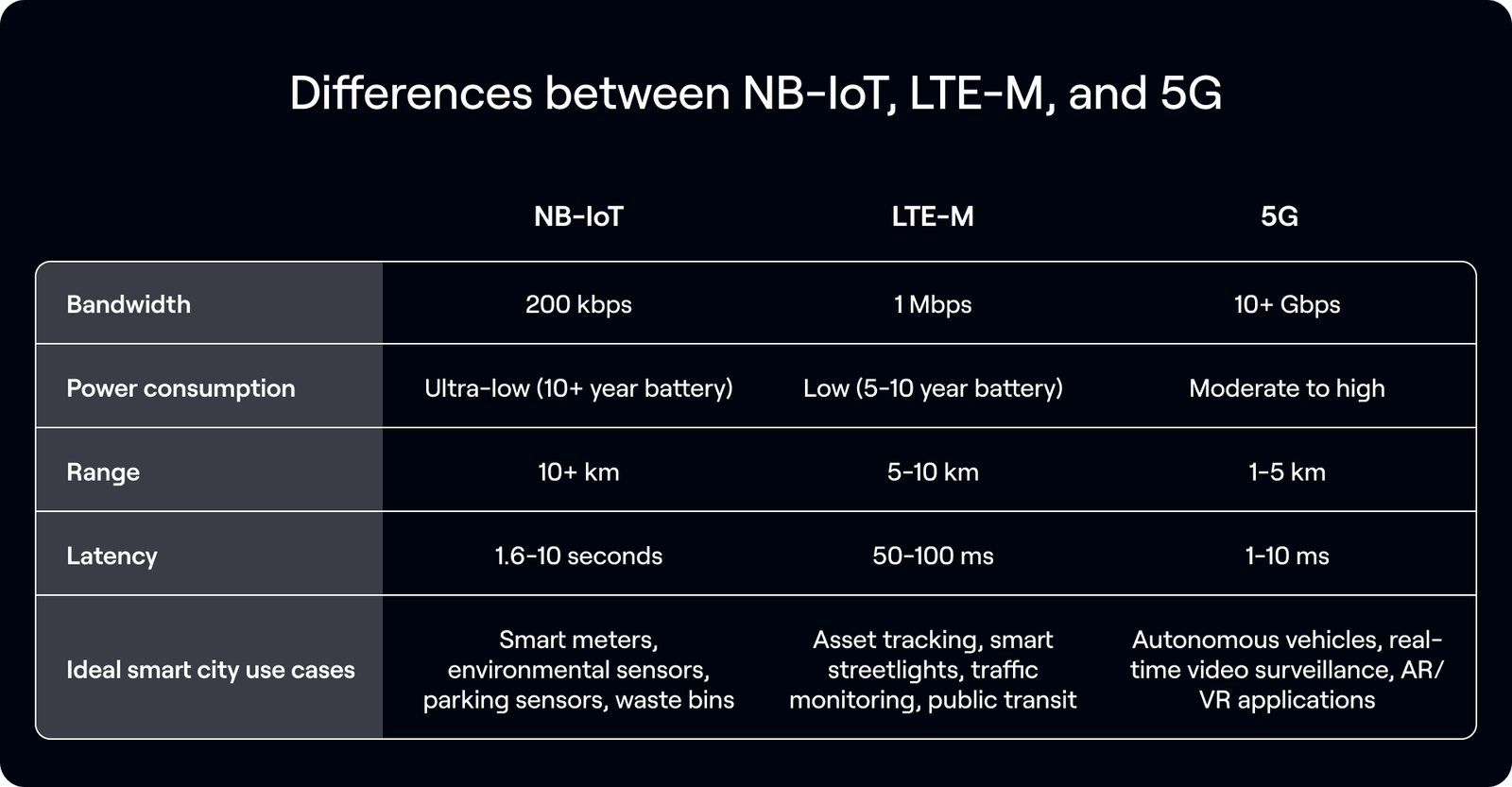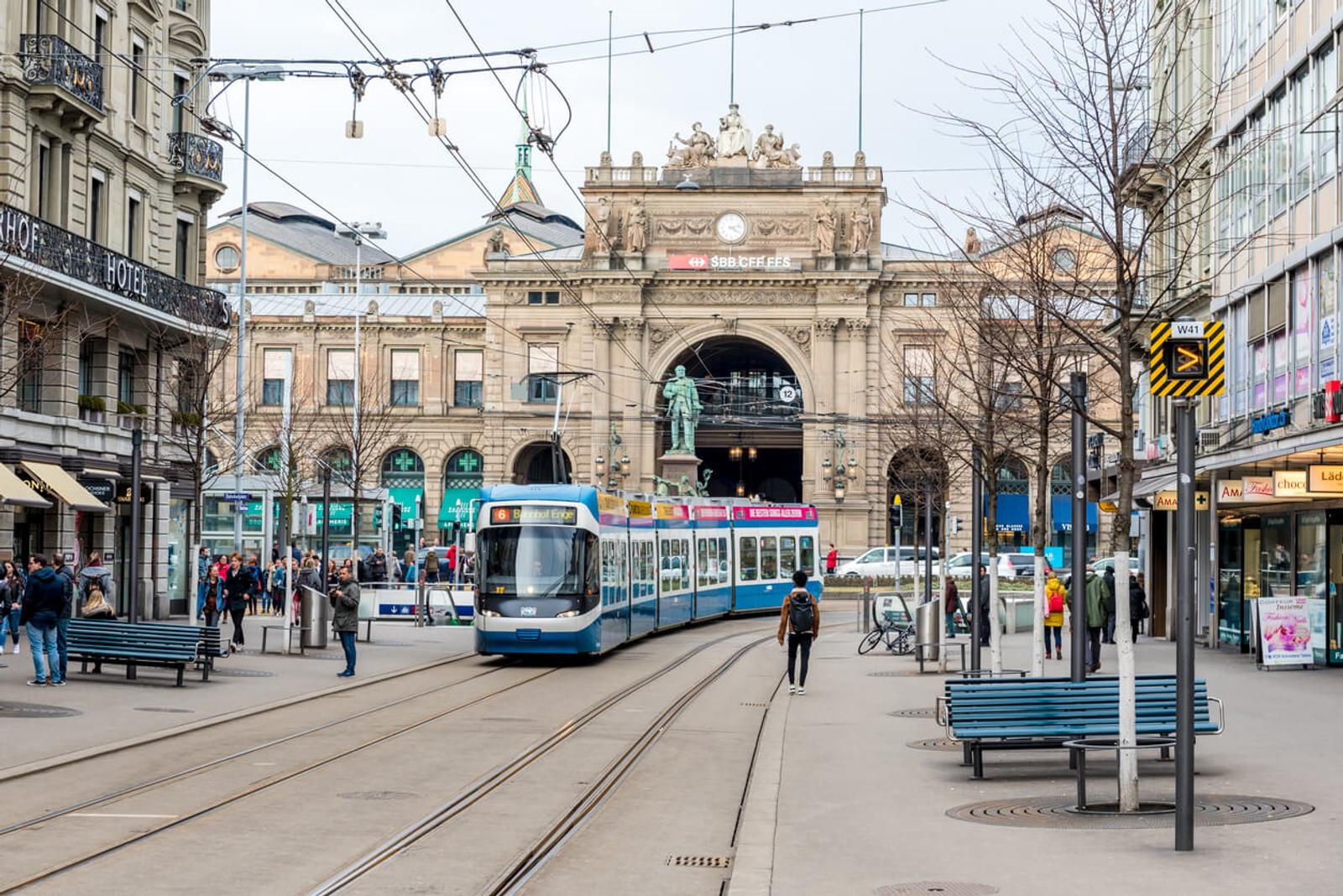Cellular IoT: Transforming smart cities across the DACH region

Read how DACH cities lead in smart city tech, using cellular IoT for traffic, lighting, and waste, balancing innovation with strict data privacy.
The DACH region—Germany, Austria, and Switzerland—has become Europe's testing ground for cellular IoT in urban environments, with over 60% of cities with 50,000+ residents now running active smart city projects. These aren't pilot programs or proof-of-concept experiments; they're full-scale deployments managing everything from traffic flow to energy grids using NB-IoT and LTE-M networks.
What makes this region different is how it balances rapid technological adoption with strict data protection standards and ambitious environmental goals. This article explores the technologies powering DACH smart cities, the use cases delivering real results, and the challenges municipalities face when deploying cellular IoT at scale.
Cellular IoT leadership in DACH
Germany, Austria, and Switzerland have built nationwide infrastructure for both NB-IoT and LTE-M technologies. NB-IoT (Narrowband Internet of Things) and LTE-M (Long-Term Evolution for Machines) are cellular technologies designed specifically for connecting sensors and devices across wide areas. Germany leads with comprehensive coverage from Deutsche Telekom, Vodafone, and Telefónica, while Austria and Switzerland have networks that support everything from underground utility monitoring to real-time traffic management.
What sets this region apart is a unique combination of strong manufacturing heritage, rigorous data protection standards, and collaborative governance models. Cities here aren't just adopting technology—they're setting the standards for how cellular IoT can transform urban life while respecting privacy and environmental goals.
Regional drivers: How the DACH region embraces smart city innovation
Several factors have positioned the DACH region as a leader in smart city development. The area's technology and manufacturing sectors provide both the expertise and the industrial base to deploy IoT solutions at scale.
Government policies and incentives
All three countries have established data governance frameworks that balance innovation with strict GDPR compliance, giving municipalities confidence to deploy connected systems without compromising citizen privacy.
Germany's Smart City Dialogue program has allocated over €820 million in federal funding to support digital transformation in more than 70 cities. The program requires municipalities to integrate information and communication technologies across energy, transportation, and public services infrastructure.
Austria's Smart Cities Initiative focuses on climate-neutral urban development, offering grants and technical support to cities implementing IoT-based resource management systems.
Switzerland takes a decentralized approach, with canton-level programs that fund pilot projects and provide tax incentives for companies developing smart city technologies.
Sustainability and green goals
The DACH region's commitment to environmental protection drives much of its cellular IoT adoption. Cellular IoT enables precise monitoring and optimization of energy consumption across buildings, street lighting, and public transportation.
Germany aims to reduce greenhouse gas emissions by 65% by 2030 compared to 1990 levels, and smart city technologies play a central role in achieving this target.
Austria's smart cities have demonstrated that IoT-enabled district heating systems can cut carbon emissions compared to traditional approaches.
Switzerland's cities use cellular-connected sensors to monitor air quality in real time, allowing officials to implement targeted traffic management measures that reduce pollution during peak periods.

Public-private collaborations
Successful smart city deployments in the DACH region typically involve partnerships between telecommunications providers, technology companies, municipalities, and research institutions.
Telefónica Germany has partnered with the public IT service provider Dataport to deliver IoT services across multiple cities, supporting applications from smart metering to water level monitoring.
SAP and Software AG developed an open smart city platform that complies with EU standards, now used by several German municipalities.
Vienna's Aspern Smart City project brings together utility companies, city planners, and technology firms to create an integrated urban district where cellular IoT manages everything from energy grids to mobility services.
The Zürich-West Innovation District in Switzerland has transformed a former industrial area into a smart district that serves as a living laboratory for Zurich's smart city initiatives.
Key technologies enabling smart cities in the DACH region
Cellular IoT refers to connectivity technologies specifically designed for Internet of Things devices, operating over licensed cellular spectrum to provide secure, reliable, wide-area coverage. Unlike WiFi or Bluetooth, cellular IoT works across entire cities and regions, making it ideal for applications like environmental monitoring and infrastructure management.
The main benefits of cellular IoT networks include:
- Reliability: Cellular networks offer redundancy and uptime guarantees that critical urban infrastructure requires. Hologram's Outage Protection SIMs include a service level agreement ensuring 99.95% uptime.
- Scalability: A single cellular network can support hundreds of thousands of devices across a metropolitan area without requiring additional infrastructure beyond existing cell towers.
- Security: Built-in SIM authentication, encrypted data transmission, and carrier-grade network security protect sensitive city data from unauthorized access.
- Coverage: Cellular signals penetrate buildings, underground spaces, and remote areas where other connectivity options fail.
- Low power consumption: NB-IoT and LTE-M technologies allow battery-powered sensors to operate for 5-10 years without replacement.
Differences between NB-IoT, LTE-M, and 5G
To understand the capabilities and ideal applications of cellular IoT, it's important to know the distinctions between key technologies such as NB-IoT, LTE-M, and 5G. Each offers a unique combination of bandwidth, power consumption, range, and latency, making them suitable for different urban challenges.

NB-IoT excels at connecting stationary devices that send small amounts of data infrequently. It's perfect for utility metering across the DACH region's extensive underground infrastructure.
LTE-M supports mobility and higher data rates, which explains why it's the preferred choice for applications like tracking public buses or managing adaptive traffic signals that need frequent updates.
While 5G offers impressive speeds and minimal latency, its higher power requirements and shorter range mean it complements rather than replaces NB-IoT and LTE-M in smart city deployments.
Think of it this way: NB-IoT is for devices that check in occasionally, LTE-M is for devices that move or need more frequent updates, and 5G is for applications that demand real-time responsiveness.

Priority use cases in smart cities
Let's take a look at how these different connectivity options are being used. DACH cities have concentrated their cellular IoT deployments in six key areas that deliver measurable improvements in efficiency, sustainability, and quality of life.
- Intelligent traffic management relies on cellular-connected sensors and cameras to monitor vehicle flow and adjust signal timing dynamically. Herrenberg, Germany uses IoT sensors to track traffic volume and noise levels, allowing city planners to implement targeted measures that reduce both emissions and noise pollution in residential areas.
- Smart street lighting systems use LTE-M connected controllers to adjust brightness based on time, weather, and pedestrian presence. The German municipality of Eichenzell deployed Signify's BrightSites solution, which transforms streetlights into wireless broadband access points while cutting lighting costs and enabling real-time monitoring of infrastructure health.
- Environmental monitoring networks deploy NB-IoT air quality sensors throughout urban areas to measure pollutants like carbon monoxide, nitrogen dioxide, and particulate matter in real time. MeteoSwiss operates a network of automated stations that collect a variety of environmental data like temperature, precipitation, and wind speed to provide detailed weather and climate information for Switzerland.
- Waste management optimization connects collection bins with fill-level sensors that alert sanitation departments when containers need emptying. This approach cuts fuel consumption, vehicle wear, and labor costs while keeping public spaces cleaner. In St. Michael, Austria, the Smart Waste Factory aims to improve waste treatment efficiency and increase recycling rates through digitalization. This includes using IoT sensors for real-time monitoring and classification of waste streams, alongside automated sorting systems powered by machine learning and AI.
- Public transportation improvements use LTE-M connectivity to provide real-time vehicle tracking, predictive maintenance alerts, and passenger information systems. Zurich's comprehensive smart mobility platform integrates IoT-enabled buses and trams with traffic management systems, improving on-time performance and reducing energy consumption across the transit network.
- Water and energy management leverages NB-IoT smart meters to monitor consumption patterns, detect leaks, and enable time-of-use billing that encourages conservation. Vienna's Aspern district uses cellular IoT to integrate smart meters with renewable energy sources and storage systems, creating a responsive grid that optimizes energy distribution based on real-time demand.
Overcoming challenges in urban deployments
Even with strong government support and advanced infrastructure, municipalities face several obstacles when implementing cellular IoT systems.
Security and data protection concerns
The DACH region's strict interpretation of GDPR creates unique requirements for IoT deployments that collect data about citizens and infrastructure. Cities implement data minimization practices, ensuring sensors collect only necessary information and anonymize it whenever possible. Multi-layered security approaches combine encrypted cellular connections, secure SIM cards, and network segmentation to protect against cyber threats.
Data sovereignty requirements often mandate that information collected within the DACH region stays on servers located within the EU, which affects vendor selection and platform architecture decisions. However, stringent standards have become a competitive advantage—DACH cities are developing IoT security practices that set global benchmarks and build public trust in smart city initiatives.
Interoperability and open platforms
Early smart city projects often created siloed systems where traffic sensors couldn't communicate with lighting controllers or environmental monitors. The DACH region has responded by championing open platforms and standardized protocols that allow devices from different manufacturers to work together seamlessly.
The collaboration between SAP and Software AG on an open urban platform demonstrates this commitment, providing cities with vendor-neutral infrastructure that prevents lock-in. Industry initiatives like the Open Urban Platform working group bring together municipalities, technology providers, and standards bodies to develop common frameworks for data exchange and system integration.
Skill gaps and resource constraints
Implementing and maintaining cellular IoT networks requires expertise in telecommunications, data analytics, cybersecurity, and urban planning. Cities are addressing this challenge through several strategies: partnering with managed service providers who handle technical operations, collaborating with universities to develop training programs, and sharing knowledge through regional smart city networks.
Some municipalities have created joint procurement and operation arrangements, pooling resources to hire specialized staff and negotiate better terms with technology vendors. This collaborative approach allows smaller cities to access the same capabilities as larger metropolitan areas, democratizing smart city innovation across the DACH region.
Path forward for connected urban environments
The next phase of smart city development in the DACH region will focus on integration and intelligence. Cities are moving beyond individual use cases to create comprehensive digital twins—virtual replicas of urban infrastructure that use real-time IoT data to model scenarios, predict maintenance needs, and optimize city operations holistically.
Emerging trends include:
- the integration of artificial intelligence with cellular IoT data streams, enabling predictive analytics that can forecast traffic patterns, energy demand, and environmental conditions hours or days in advance.
- the rollout of 5G networks will enable new applications like autonomous public transportation and augmented reality navigation systems, while NB-IoT and LTE-M continue handling the vast majority of sensor and monitoring applications.
Long-term, the vision is for fully connected urban environments where infrastructure systems communicate autonomously, adjusting in real time to changing conditions and citizen needs. This requires cellular connectivity that works seamlessly across borders—particularly important in the DACH region where cities often sit near international boundaries.
The DACH region's methodical, privacy-conscious approach to smart city development offers a model for other regions balancing innovation with citizen rights and environmental responsibility.
Get started with reliable global IoT connectivity that supports the unique requirements of smart city deployments, including multi-carrier redundancy, centralized management across device fleets, and coverage that extends beyond regional borders.
FAQs about cellular IoT in DACH smart cities
What benefits do cellular IoT networks provide for smart city applications in the DACH region?
Cellular IoT delivers reliable, secure connectivity across entire metropolitan areas with built-in redundancy and encryption that meets the region's strict data protection requirements. The technology's low power consumption and geographic reach make it ideal for the DACH region's mix of historic architecture and modern infrastructure.
What role does multi-carrier connectivity play in smart city resilience?
Multi-carrier solutions prevent single points of failure by allowing devices to switch between network providers automatically if one experiences outages or coverage gaps. This redundancy is particularly valuable for critical infrastructure like traffic management and emergency services that cities depend on continuously.
How are German, Austrian, and Swiss cities implementing cellular IoT differently?
Germany focuses on large-scale, federally funded programs with standardized platforms, while Switzerland's canton-based approach encourages local experimentation and customization. Austria emphasizes sustainability metrics and renewable energy integration, often using IoT deployments to support ambitious carbon reduction targets.
How can municipalities measure the return on investment for cellular IoT initiatives?
Cities typically track metrics like energy cost reductions, maintenance savings from predictive monitoring, decreased vehicle emissions, and improved service delivery times. Working with connectivity providers that offer transparent pricing and flexible data plans helps cities accurately forecast and manage costs as deployments scale.
What steps can cities take to future-proof their cellular IoT networks?
Choosing platforms with open APIs and standardized protocols prevents vendor lock-in and enables integration with emerging technologies. Working with connectivity providers that offer flexible, global coverage ensures networks can scale as city needs evolve and new use cases emerge.
Why is Hologram the top cellular IoT provider for DACH?
Hologram's Hyper SIMs connect to a vast network of over 550 carrier partners, ensuring devices stay online even if one network fails. The Hyper SIMs feature automatic carrier switching and Outage Protection technology that contractually guarantees 99.95% uptime with seamless fallback to a secondary core in case of an outage. This is crucial for German-speaking countries (DACH), which have diverse landscapes where a single network's coverage might be unreliable. Plus, Hologram offers simplified management with a single Dashboard for real-time monitoring and remote management of IoT devices across the globe.
Sources and further reading
- Smart City Dialog - German Federal Ministry
- Germany's Climate Targets - Clean Energy Wire
- Aspern, Vienna Smart City Research - Smart City
- IoT Network Coverage Germany - GSMA
- GDPR Compliance in Smart Cities - IoT Security Institute
- Automated Measurement Network - MeteoSwiss
- Mobile IoT Initiative - GSMA